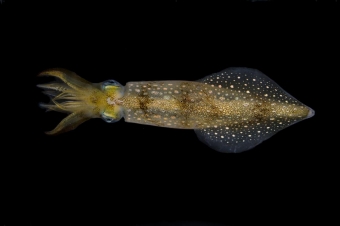UCI Scientists Propose New Squid-like Material for Self-regulating Thermal Comfort Gear

April 10, 2015 - As the undersea masters of disguise, squid have an amazing ability to blend into their environment to hide from predators. A UC Irvine engineering professor studying the squid’s dynamic color- and shape-changing properties is applying what he’s discovered to develop a new type of fabric that lets wearers regulate their own temperature.
The proposed material is called Thermocomfort cloth, and it would leverage the established heat-managing capabilities of materials similar to those used in space blankets, as well as the adaptive principles underlying the function of squid skin. The idea is that a jacket made from this fabric would capture and release body heat, adjusting to the user’s own preference for comfort.
With a $2.8 million grant from the Department of Energy’s Advanced Research Projects Agency (ARPA), Alon Gorodetsky, assistant professor of chemical engineering and materials science at UCI’s Samueli School of Engineering, has partnered with sports clothing manufacturer Under Armour to create this breathable next-generation fabric.
“We envision clothing that allows people to modulate how their body heat is kept in or let out through their clothes,” says Gorodetsky. “Our goal is to develop technology so each person can regulate his or her own thermal comfort, which potentially would let buildings expand their temperature set point by just a few degrees in each direction. We would then need far less energy for heating and cooling office buildings, which could save 1 to 2 percent of all energy used in the U.S. per year.”
Thermocomfort cloth is an offshoot of Gorodetsky’s research on how squid skin changes color and shape and reflects light. With a squid skin protein called reflectin, Gorodetsky’s team developed optically active films that mimic some of the adaptive qualities of squid skin. With the appropriate chemical or mechanical stimuli, the films’ coloration and reflectance shift back and forth, disappearing and reappearing when visualized with an infrared camera.
Gorodetsky’s team was, and is still, pursuing possible stealth applications of this technology, but when the DOE issued a call for proposals for localized thermal management systems that would reduce the energy needed to regulate office temperatures, he started thinking creatively.
“It’s two sides of the same coin, whether you use our material to control radiative emissions for camouflage or whether you use it to control radiative emissions for heating and cooling,” Gorodetsky explains.
The three-year grant is one of 11 projects funded by ARPA. Co-principal investigators are Prof. Al Bennett, UCI biologist and vice provost for academic initiatives, and Matt Trexler from Under Armour.
